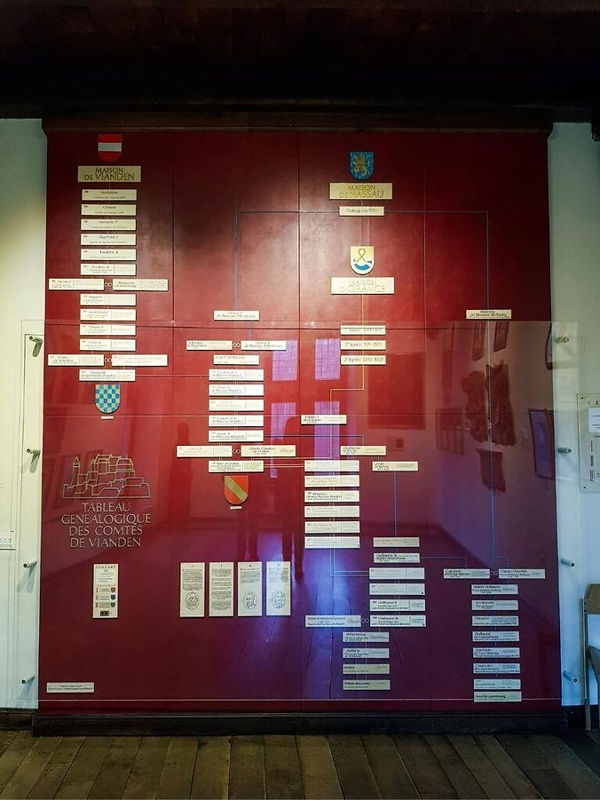
Orange House
(Genealogy room)

This room is situated on the first floor of a building erected from 1617 - 1620.
Since the 14th century the baillifs of the counts had their own appartments in a building known as "Julich house". This house fell into disrepair in the 16th century, so the administrators had to move to other parts of the castle (old & main kitchen appartments). After the Orange family got back to the county of Vianden (confiscated by the spanish crown in 1568) in 1604 , they decided to build a new appartment bloc for the administration staff.
This consisted mainly in two "towers" with 5 apartments. The works started in 1617 and were officially finished in 1620 when the house was inaugurated by installing a stone inscription and arms of the princes Philipp-William & Maurice of Orange-Nassau under whose reigns the construction took place, visible today in this room. Nevertheless it took longer to finish the appartments, with windows, woodwork & finishing taking some more years to accomplish.
There is only one of the two towers still standing today, the second once having been at the far end of the adjoicent terrace. In between the two towers on the terrace had been a rainwater-flushed latrine (toilet).
the dynasty of the counts of Vianden

The pedigree shows the counts of Vianden since the first known, count Bertolph. The first golden age of Vianden as centre of an important domain was in the 12th - 13th century from Count Frederic I to Henry I. This line ends 1417 with Elisabeth of Sponheim-Vianden. Vianden passes to Nassau-Dillenbourg, later Orange-Nassau-Dillenbourg, leading to a second golden age in the 15th - 16th century.
In the souvenir shop the standard work for this dynasty is available in german language: "Die Grafen von Vianden" by Jean Milmeister.
text and arms carved in stone

The latin inscription commemorates Philipp-William of Orange as comissioner of the building and Maurice of Orange to have accomplished it and is signed by Aegide Bouvet, "Quastore" (finance administrator) of the county of Vianden.
The arms of Philipp-William (left):
main shield: Nassau (top left), Katzenelnbogen (top right), Vianden (bottom left), Diez (bottom right)
centre shield: Chalon (top left & bottom right) & Orange (top right & bottom left)
heart shield: Geneva
surrounded by the chain of the order of the golden fleece
The arms of Maurice (right):
top left & bottom right: Nassau, Katzenelnbogen, Vianden, Diez, centre Moers
top right & bottom left: Chalon, Orange, centre Geneva
heart shield: Buren
William I of Orange bust

William I of Orange, called the taciturn, also "father of the Netherlands". He was meeting his brothers John the elder of Nassau & Louis of Nassau and his brother-in-law Konrad of Solms on 16th November 1566 at Vianden castle to discuss the political situation in the northern provinces of the low countries.
As a result he became a leader in the conflict which led to war in 1568, the beginning of the 80th years war, which led to the independence of the Netherlands.
